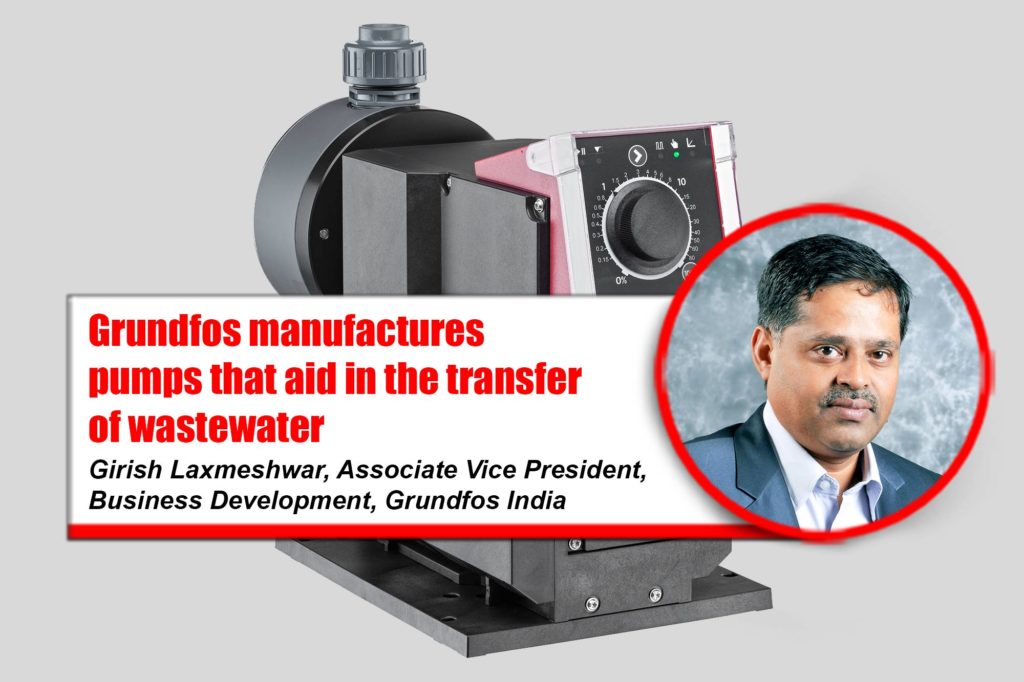These solutions are specifically designed to handle wastewater with solids efficiently says Girish Laxmeshwar, Associate Vice President, Business Development, Grundfos India.
When it comes to industrial wastewater treatment, is the process selection based on the type of industry in question?
Water used for manufacturing is usually contaminated during the process and is converted to wastewater. The nature of the contaminants varies on the basis of the industry. For example, the waste generated from a power industry would be different than that of waste generated in the pulp and paper industry. This is the same case for waste generated in the food industry and a tannery. The physical, chemical and biological characteristics of these contaminants must be studied extensively to identify the ideal wastewater treatment plan.
• Physical characteristics: turbidity, colour, odour, suspended solids and temperature among others
• Chemical characteristics: Chemical Oxygen Demand (COD), Total Organic Carbon (TOC), pH value and presence of chemical components such as chlorides, nitrogen, phosphorus, sulfate and heavy metals
• Biological characteristics: Biological Oxygen Demand (BOD) and microbial pollutants
In which industries does the Brine treatment prove useful, how does it help in removing the contaminants of wastewater?
Brine is primarily generated through raw water treatment or in Zero Liquid Discharge (ZLD) units in industries that discharge the brine as wastewater in the effluent. The wastewater is generally disposed through various evaporation technologies such as pond evaporation, spraying (mist) evaporation, multi effect evaporation and mechanical evaporation.
• Pond evaporation system: The brine or the reject water is stored in a large pond that is exposed to sunlight to trigger natural evaporation.
• Mist evaporation system: The reject water is pumped through a high-pressure nozzle system that helps accelerate the evaporation process.
• Multi effect evaporation system: The wastewater is boiled in a series of vessels to generate steam and separate the solid waste.
Brine is produced as reject water in almost every industry with an RO system or a ZLD unit. Recovery of water from brine reduces the industry’s dependency on fresh water. In some cases, the steam generated from brine is also used in various processes. However, technologies for these processes must be carefully evaluated as they will have a cost impact on the industry.
What is Biochemical Oxygen Demand (BOD) and its advantages for wastewater management?
Biochemical Oxygen Demand (BOD) is the total quantity of oxygen consumed during the aerobic process of decomposition of organic materials due to microorganisms in wastewater. BOD can therefore provide information on the biologically convertible proportion of the organic matter in a sample of the wastewater.BOD is represented in mg/l unit of oxygen and is usually measured over a period of 5 days. The value of BOD is directly proportional to the content of organic matter and Dissolved Oxygen (DO) in the water. Reduction of BOD is used to gauge the effectiveness of wastewater treatment plants. It is important to ensure a specific BOD or DO level in water to maintain aquatic life, before the treated water is released.
Could you shed some light on solutions provided by your company for wastewater?
Grundfos has a host of solutions that cater to various aspects of wastewater processes. We predominantly manufacture pumps that aid in the transfer of wastewater. These solutions are specifically designed to handle wastewater with solids efficiently.
Grundfos’ submersible range of mixers and flow makers are used in equalization or aeration tanks to improve the efficiency of oxygen transfer. High quality Grundfos dosing pumps are provided by the company to dose chemicals in water for coagulation and flocculation processes, and for pH correction. Our product portfolio also includes aeration ejector pumps and disc aerators.
Cookie Consent
We use cookies to personalize your experience. By continuing to visit this website you agree to our Terms & Conditions, Privacy Policy and Cookie Policy.


















